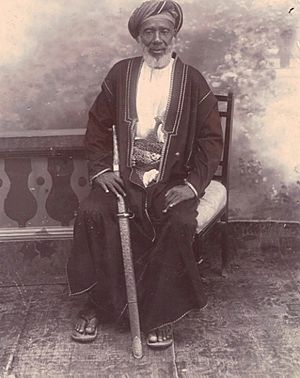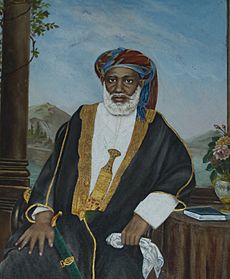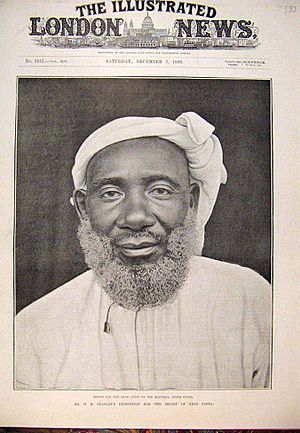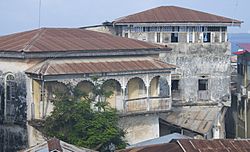Tippu Tip facts for kids
Quick facts for kids
Tippu Tip
|
|
|---|---|
 |
|
| Born |
Hamad bin Muhammad bin Juma bin Rajab el Murjebi
1832 |
| Died | June 14, 1905 (aged 73) Stone Town, Sultanate of Zanzibar
|
| Other names | Tippu Tib |
| Occupation | Slave trader, ivory merchant, explorer, governor |
Tippu Tip, also known as Tippu Tib (born around 1832 – died June 14, 1905), was a very important figure in East African history. His real name was Hamad bin Muhammad bin Juma bin Rajab el Murjebi. He was an Afro-Arab explorer, a powerful trader of ivory, and a plantation owner. He also served as a governor for the Sultan of Zanzibar.
Tippu Tip led many trading trips deep into Central Africa. He set up successful trading posts in these areas. He would buy ivory from local people and then sell it for a good profit at ports along the coast. He was also involved in the trade of people, which was a common but terrible practice at the time.
Contents
Early Life and His Nickname
Tippu Tip was born around 1832 on the island of Zanzibar. His mother was a high-ranking Muscat Arab. His father and grandfather were coastal Arabs from the Swahili coast. They had been part of the first trading trips into the African interior.
His great-grandmother was from a respected Muscat family and a Bantu woman. She came from a small village south of what is now Dar es Salaam.
Hamad bin Muhammad bin Juma bin Rajab el Murjebi was mostly known as Tippu Tib. This nickname means "the gatherer of wealth." He said he got the name "Tippu Tip" because of the "tiptip" sound his guns made during his expeditions.
When he was quite young, Tippu Tip led a group of about 100 men. They traveled into Central Africa looking for ivory and to trade for people. After exploring large areas, he went back to Zanzibar. He gathered more resources and recruited more people for his group. Then, he returned to mainland Africa.
Building a Trading Empire

Tippu Tip built a large trading network. He used the money he earned to start clove plantations on Zanzibar. One historian, Abdul Sheriff, noted that when Tippu Tip began his "empire building" on the mainland, he didn't own any plantations. But by 1895, he had acquired seven large plantations and many workers.
He met and helped several famous European explorers in Africa. These included David Livingstone and Henry Morton Stanley. Between 1884 and 1887, he claimed parts of the Eastern Congo for himself and for the Sultan of Zanzibar. Even though he protected Zanzibar's interests in the Congo, he kept good relationships with the Europeans.
In 1886, some fighting broke out between the Swahili and representatives of King Leopold II of Belgium. Tippu Tip went to the Belgian consul in Zanzibar. He wanted to assure them of his "good intentions." By 1886, he could see that power in the region was changing.
Governor of Stanley Falls
In early 1887, Henry Morton Stanley arrived in Zanzibar. He suggested that Tippu Tip become the governor of the Stanley Falls District in the Congo Free State. Both King Leopold and Sultan Barghash bin Said of Zanzibar agreed. On February 24, 1887, Tippu Tip accepted this important role.
At the same time, he agreed to help with an expedition. Stanley was organizing this trip to rescue Emin Pasha. Emin Pasha was a German governor who was stuck in a region of Sudan.
Tippu Tip traveled back to the Upper Congo with Stanley. This time, they went by way of the Atlantic coast and up the Congo River. The expedition faced many difficulties. Stanley even tried to blame Tippu Tip for some problems.
Conflict in the Congo
After Tippu Tip finished his time as governor, a conflict known as the Congo–Arab War began. Both sides in this war used armies made mostly of local African soldiers. These soldiers fought under the command of either Arab or European leaders.
When Tippu Tip left the Congo, King Leopold's Free State still had weak control in the eastern parts of the area. Local Arab or Swahili leaders held most of the power. Among these leaders were Tippu Tip's son, Sefu bin Hamid, and a trader named Rumaliza.
In 1892, Sefu bin Hamed attacked Belgian ivory traders. These traders were seen as a threat to the Arab-Swahili trade. The Free State government sent a force led by commander Francis Dhanis to the East. Dhanis had an early success when an African leader named Ngongo Lutete switched sides to join him. The Belgian force was better armed and organized. They defeated their opponents in several battles. Sefu died on October 20, 1893. Finally, Rumaliza was also forced to flee to German territory in 1895.
Later Years and Death
Tippu Tip returned to Zanzibar around 1890 or 1891 and retired. He decided to write down his life story. This was the first autobiography written in the Swahili language. Dr. Heinrich Brode, who knew Tippu Tip in Zanzibar, wrote down the story in Roman letters. He then translated it into German.
Later, it was translated into English and published in Britain in 1907.
Tippu Tip died on June 13, 1905. He passed away from malaria in his home in Stone Town, the main town on the island of Zanzibar.
See also
 In Spanish: Tippu Tip para niños
In Spanish: Tippu Tip para niños



